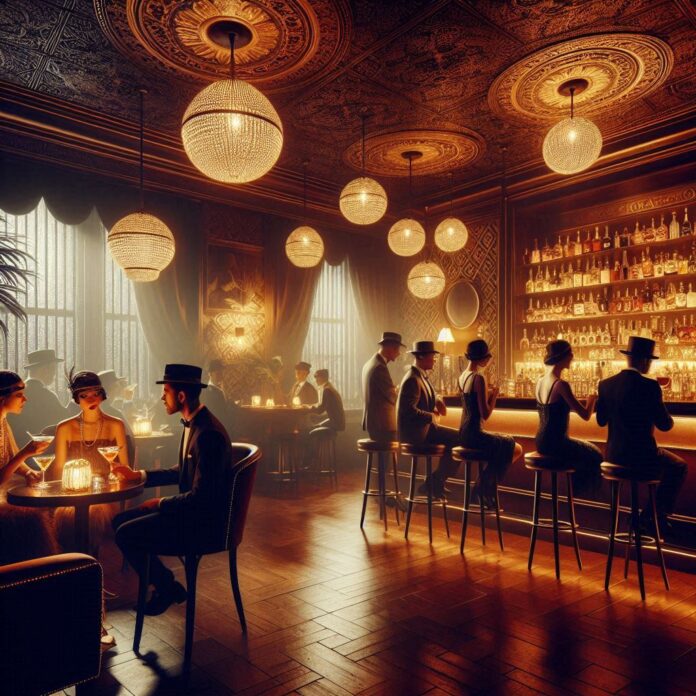An In-Depth Look at History, Culture, and Modern Revival
Introduction to Speakeasies
The term “speakeasy” might evoke images of clandestine bars, hidden doors, and whispered secrets. These establishments, which gained prominence during the Prohibition era, have left an indelible mark on American culture. But what exactly is a speakeasy? In this article, we will explore the rich history, cultural significance, and modern revival of speakeasies. By the end, you’ll have a thorough understanding of these intriguing establishments and their enduring appeal.
Historical Context and the Prohibition Era
The Origins of Prohibition
The journey of speakeasies begins with the enactment of Prohibition in the United States. On January 17, 1920, the 18th Amendment to the Constitution came into effect, banning the manufacture, sale, and transportation of alcoholic beverages. This era, known as Prohibition, was driven by the temperance movement, which advocated for the reduction of alcohol consumption due to its perceived social and health impacts.
Rise of Speakeasies
With the legal sale of alcohol prohibited, a lucrative black market emerged. Enter the speakeasies: clandestine bars and nightclubs where people could still enjoy a drink away from prying eyes. The term “speakeasy” is believed to have originated from the practice of patrons speaking quietly or “easily” to avoid detection by authorities. These establishments operated in basements, behind unmarked doors, and in hidden rooms, often requiring a password or secret knock to gain entry.
Notorious Figures and Bootlegging
The Prohibition era also saw the rise of notorious figures like Al Capone, who capitalized on the demand for illegal alcohol. Bootleggers smuggled and distributed alcohol, making fortunes in the process. Speakeasies, often supplied by these bootleggers, became hotbeds of criminal activity, jazz music, and social rebellion.
The Cultural Significance of Speakeasies
A Hub for Social Change
Speakeasies were more than just places to drink; they were hubs of social change. These establishments broke down societal barriers, allowing people from different backgrounds to mingle and socialize. Women, who were previously discouraged from frequenting bars, found a new sense of freedom in speakeasies. The vibrant atmosphere of these hidden bars also provided a platform for the burgeoning jazz scene, with legendary musicians like Louis Armstrong and Duke Ellington performing regularly.
Fashion and Flappers
The speakeasy culture also influenced fashion. The 1920s saw the rise of the “flapper”—young women who defied traditional norms with their short skirts, bobbed hair, and liberated lifestyles. Flappers epitomized the spirit of the Jazz Age, embracing the lively, carefree atmosphere of speakeasies.
Political and Economic Impact
Politically, the failure of Prohibition highlighted the challenges of legislating morality and the unintended consequences of such measures. Economically, speakeasies generated significant revenue, albeit through illegal means. The eventual repeal of Prohibition in 1933, with the 21st Amendment, marked the end of an era but left a lasting legacy.
Notable Speakeasy Locations Then and Now
Famous Speakeasies of the Prohibition Era
- 21 Club, New York City The 21 Club was one of the most famous speakeasies in New York City. It featured a hidden wine cellar and a network of secret passages, making it a favorite among celebrities and politicians.
- Green Mill Cocktail Lounge, Chicago A haunt for Al Capone, the Green Mill Cocktail Lounge in Chicago was known for its jazz performances and mob connections. Today, it remains a popular nightlife destination.
- The Cotton Club, Harlem The Cotton Club in Harlem was renowned for its jazz music and extravagant performances. It was a cultural landmark that showcased the talents of African American artists during a time of segregation.
Modern Speakeasies
The allure of speakeasies has not waned, and in recent years, there has been a revival of speakeasy-style bars. Here are a few notable modern speakeasies:
- Please Don’t Tell (PDT), New York City Hidden behind a vintage phone booth in a hot dog restaurant, PDT is a modern speakeasy known for its creative cocktails and intimate atmosphere.
- The Back Room, Los Angeles Located behind an unmarked door in a back alley, The Back Room offers a nostalgic Prohibition-era experience with its vintage decor and craft cocktails.
- Evans & Peel Detective Agency, London Disguised as a detective agency, this London speakeasy requires guests to “present their case” to gain entry. Inside, patrons can enjoy a wide range of cocktails in a 1920s-inspired setting.
The Revival of Speakeasy Culture in Modern Bars
Why the Revival?
The modern revival of speakeasy culture can be attributed to several factors. Firstly, the allure of exclusivity and mystery continues to captivate patrons. The hidden entrances, secret passwords, and unique themes offer an experience that contrasts sharply with mainstream bars. Secondly, there is a growing appreciation for craft cocktails and mixology. Speakeasies often pride themselves on their expertly crafted drinks, drawing in enthusiasts seeking quality over quantity.
Craft Cocktails and Mixology
The modern speakeasy movement has placed a significant emphasis on craft cocktails and mixology. Bartenders in these establishments are often skilled artisans who create unique and innovative drinks using high-quality ingredients. The art of mixology has become a central feature of the speakeasy experience, with many bars offering custom cocktails tailored to individual preferences.
Themed Decor and Ambiance
The ambiance of modern speakeasies is carefully curated to evoke the spirit of the Prohibition era. From vintage decor and dim lighting to jazz music and period costumes, these bars transport patrons back in time. The attention to detail creates an immersive experience that is both nostalgic and novel.
Community and Social Connection
Speakeasies also foster a sense of community and social connection. The intimate and exclusive nature of these bars encourages interaction among patrons. Whether it’s sharing stories, enjoying live music, or simply savoring a well-crafted drink, the speakeasy environment promotes a sense of camaraderie and belonging.
Conclusion: The Enduring Appeal of Speakeasies
Speakeasies have left an indelible mark on American culture, from their origins in the Prohibition era to their modern-day revival. These hidden bars symbolize a spirit of rebellion, creativity, and social change. The allure of secrecy, the appreciation for craft cocktails, and the nostalgic ambiance continue to draw patrons to speakeasy-style bars today. Whether you’re seeking a taste of history or a unique night out, speakeasies offer an experience that is both timeless and unforgettable.
As we raise our glasses to the past and present, it’s clear that the charm of the speakeasy is here to stay. Cheers to the enduring appeal of these hidden gems!


